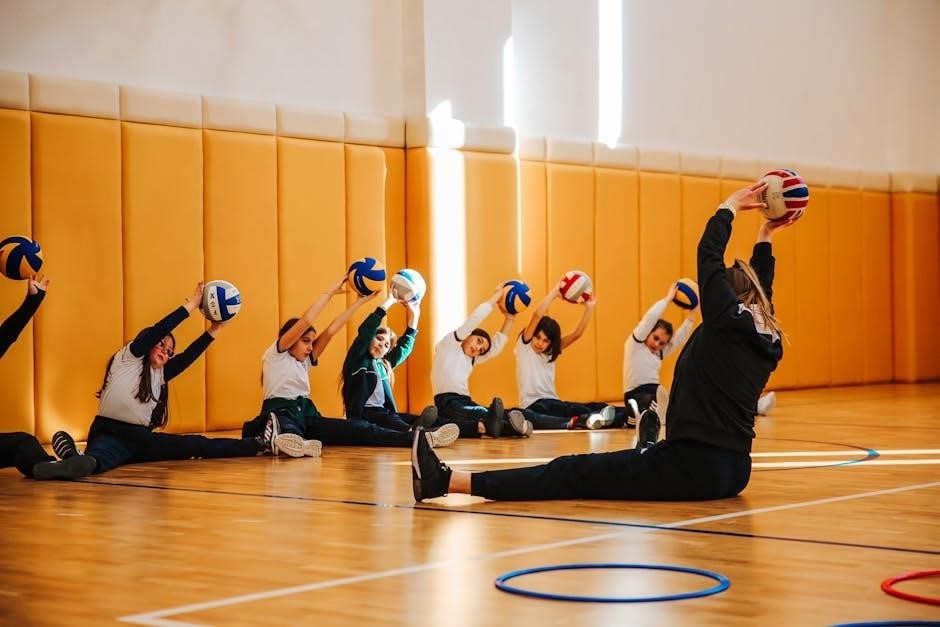Robert Gagné’s Nine Events of Instruction provides a structured framework for designing effective learning experiences. This model, outlined in his 1965 book, The Conditions of Learning, offers a systematic approach to instructional design, ensuring that each phase of the learning process is addressed to maximize engagement and retention. By following these events, educators can create meaningful and goal-oriented lessons tailored to diverse learning environments, including traditional classrooms and online platforms. Gagné’s methodology remains a cornerstone in instructional design, emphasizing clear objectives, active participation, and feedback to enhance learning outcomes.
Overview of the Model
Gagné’s Nine Events of Instruction is a comprehensive, step-by-step instructional design model that organizes teaching strategies to enhance learning outcomes. Developed by Robert Gagné in 1965, the model outlines nine distinct events that educators can follow to create structured and effective lessons. These events are sequential, with each step building on the previous one to ensure learners remain engaged, understand the material, and achieve the desired learning objectives. The model emphasizes clear communication of goals, active learner participation, and timely feedback. Its flexibility allows it to be adapted across various educational settings, including traditional classrooms and online learning environments. By aligning with psychological principles of learning, Gagné’s framework ensures that instruction is systematic, meaningful, and tailored to the needs of learners. This approach remains widely used due to its simplicity and effectiveness in promoting deep understanding and skill acquisition.

Historical Context and Development
Robert Gagné’s Nine Events of Instruction was first introduced in his 1965 book, The Conditions of Learning, marking a significant shift in instructional design. Gagné, a pioneer in educational psychology, aimed to create a systematic approach to teaching that aligned with behavioral psychology principles. His work built on earlier theories of learning, emphasizing observable behaviors and measurable outcomes. The model was developed during a period of growing interest in structured teaching methods, particularly in corporate training and military education. Over time, Gagné refined his ideas, collaborating with other educators like Leslie Briggs and Walter Wager, to ensure the model’s practical application across diverse settings. By the 1990s, the Nine Events of Instruction had become a cornerstone of instructional design, influencing both traditional and digital learning environments. Its enduring relevance lies in its ability to adapt to evolving educational needs while maintaining a focus on learner-centered outcomes.

The Nine Events of Instruction in Detail
Gagné’s Nine Events of Instruction is a systematic approach to instructional design, comprising nine specific events that guide educators in engaging learners, providing feedback, and enhancing retention effectively.
Event 1: Gain Attention
Gaining attention is the first and foundational event in Gagné’s model, designed to capture learners’ interest and focus. This step is crucial, especially in online environments where distractions are common. Educators can use various strategies such as storytelling, videos, or thought-provoking questions to engage learners. The goal is to ensure that learners are mentally prepared and receptive to the upcoming content. By stimulating curiosity or interest, this event sets the stage for effective learning. In traditional classrooms, instructors might use demonstrations or interactive activities, while in e-learning, multimedia elements like animations or scenarios can be employed. Tailoring the approach to the audience ensures maximum impact, making this event indispensable for successful instruction.
Event 2: Inform Learners of the Objectives
Informing learners of the objectives is the second event in Gagné’s model, ensuring clarity and direction for the learning process. This step involves clearly stating what learners will achieve by the end of the lesson or course. Objectives should be specific, measurable, and aligned with the overall goals of the instruction. By sharing these objectives, educators help learners understand the purpose of the content and what they will be able to do or know afterward. This step also helps reduce confusion and focuses learners’ efforts on the most important outcomes. In both traditional and online settings, clearly defined objectives guide the design of subsequent instructional events and ensure that all activities are purposeful and aligned with desired results. This clarity enhances learner engagement and motivation, setting a strong foundation for the rest of the learning experience.
Event 3: Stimulate Recall of Prior Learning
Stimulating recall of prior learning is the third event in Gagné’s model, designed to activate learners’ existing knowledge and skills relevant to the new content. This step helps learners connect new information to what they already know, making the learning process more meaningful and efficient. Techniques such as discussions, quizzes, or real-world examples can be used to prompt learners to recall previous experiences or knowledge. By bridging the gap between prior learning and new content, educators ensure that learners have a solid foundation to build upon. This event also helps learners recognize the relevance of the material, increasing engagement and readiness to absorb new information. Effective implementation of this step ensures that learning is incremental and reinforces long-term retention of skills and knowledge. It is a critical bridge between introduction and the presentation of new content.
Event 4: Present the Content
Presentation of the content is the fourth event in Gagné’s model, where the actual learning material is delivered to the learners. This step involves clearly and logically presenting the information, ensuring it aligns with the predefined objectives. The content should be organized in a way that builds on prior knowledge and maintains learner engagement. Effective presentation strategies include using examples, demonstrations, and visual aids to enhance understanding. It is crucial to deliver the material at a pace that allows learners to process the information without feeling overwhelmed. Clarity and relevance are key to ensuring that learners can connect the new content to their existing knowledge base. This event lays the foundation for the subsequent steps, where learners will practice and apply what they have learned.
Event 5: Provide Learning Guidance
Event 5 focuses on providing structured support to learners to enhance their understanding and application of the content. This involves organizing information clearly, using visual aids, and offering additional resources to facilitate comprehension. Guidance may include differentiated instruction to meet various learning needs and interactive opportunities to keep learners engaged. The goal is to create a supportive environment that aids learners in navigating the material effectively, ensuring they are well-prepared for subsequent steps like practice and assessment. By offering tailored support, educators can address individual learning styles and preferences, fostering a more inclusive and effective learning experience. This step is crucial for reinforcing the content presented in Event 4 and setting the stage for active participation in Event 6.
Event 6: Elicit Performance (Practice)
Event 6 involves providing learners with opportunities to actively apply what they have learned, enabling them to demonstrate their understanding and skills. This step encourages learners to engage in practice activities such as exercises, quizzes, or simulations, allowing them to connect new knowledge with real-world applications. The goal is to bridge the gap between theory and practice, ensuring learners can perform tasks confidently. Feedback during this phase helps identify areas where learners may need additional support. By eliciting performance, educators can assess the effectiveness of prior instruction and ensure learners are prepared for the next stages of learning. This active engagement reinforces retention and builds the foundation for further development, making it a critical step in the instructional process.
Event 7: Provide Feedback
Providing feedback is a critical step in the learning process, as it helps learners understand their performance and identify areas for improvement. Feedback should be specific, immediate, and constructive, focusing on the task rather than the individual. This step reinforces correct behaviors and clarifies misconceptions, ensuring learners can build on their strengths and address weaknesses. Feedback can be delivered through various methods, such as verbal comments, written notes, or automated responses, depending on the learning environment. The goal is to create a supportive and transparent dialogue, enabling learners to reflect on their progress and take ownership of their learning. By incorporating feedback, educators can enhance retention, improve understanding, and guide learners toward achieving the desired outcomes. This step is essential for fostering a growth mindset and promoting continuous improvement in learners.
Event 8: Assess Performance
Assessing performance is a crucial step in Gagné’s Nine Events of Instruction, serving as a means to evaluate whether learners have achieved the desired learning outcomes. This event involves using various assessment methods such as tests, quizzes, projects, or observations to measure learners’ understanding and application of the content. Gagné emphasizes the importance of aligning assessments with the established learning objectives, ensuring that the evaluation methods reflect the skills and knowledge targeted in the instruction. Additionally, assessments should ideally incorporate both formative and summative approaches—formative to provide ongoing feedback during the learning process, and summative to determine the final achievement of objectives. The goal of this event is to ensure that learners have successfully acquired the intended knowledge and skills, providing educators with insights to refine their instructional strategies and address any gaps in learning. Effective assessment in this context is fair, reliable, and valid, ultimately contributing to the overall effectiveness of the learning experience.
Event 9: Enhance Retention and Transfer
Enhancing retention and transfer is the final step in Gagné’s Nine Events of Instruction, focusing on helping learners retain the information and apply it in real-world contexts. This event involves summarizing key points, providing additional resources, and encouraging learners to reflect on their learning. Techniques such as discussions, group activities, or real-world applications can reinforce retention. Transfer of learning is achieved by connecting the content to learners’ experiences, making it more relevant and practical. This step ensures that learners can apply what they’ve learned beyond the instructional setting, making the learning experience more meaningful and long-lasting. By reinforcing retention and transfer, educators help learners achieve sustained competence and confidence in using the acquired knowledge and skills.

Application in Modern Educational Settings

Gagné’s Nine Events of Instruction are widely applied in both traditional classrooms and e-learning environments. Their versatility ensures effective learning experiences across diverse educational settings, fostering engagement and sustained outcomes.
Traditional Classroom Instruction
Gagné’s Nine Events of Instruction are effectively applied in traditional classrooms to enhance learning experiences. Teachers start by gaining students’ attention through engaging activities like questions or videos. They then inform learners of clear, specific objectives, ensuring students understand the lesson’s goals. Stimulating recall of prior learning through summaries or review questions helps connect new content to existing knowledge. Presenting the content involves diverse methods such as lectures, discussions, and demonstrations to cater to various learning styles. Providing learning guidance includes offering examples and support to aid comprehension. Eliciting performance through group activities or exercises allows students to apply what they’ve learned. Timely feedback is provided to guide improvement, and performance is assessed through quizzes or projects aligned with objectives. Finally, retention and transfer are enhanced by reviewing key points and encouraging real-world application, ensuring long-term understanding and practical use of skills.
E-Learning and Online Education
Gagné’s Nine Events of Instruction are highly adaptable to e-learning and online education, offering a structured approach to digital learning design. In online environments, gaining attention is achieved through multimedia elements like videos or interactive simulations. Informing learners of objectives is done via clear instructions and downloadable resources. Stimulating prior learning occurs through self-assessment quizzes or review modules. Presenting content involves SCORM packages, slide presentations, and gamified activities. Learning guidance is provided through discussion forums, live chats, and automated hints. Eliciting performance is facilitated by interactive exercises and practice quizzes. Feedback is immediate and specific, often generated by the learning management system (LMS). Assessments are conducted through automated tests, and retention is enhanced by summary modules and application exercises. This model ensures consistent, engaging, and effective learning experiences in digital spaces, aligning with Gagné’s emphasis on structured and goal-oriented instruction.



